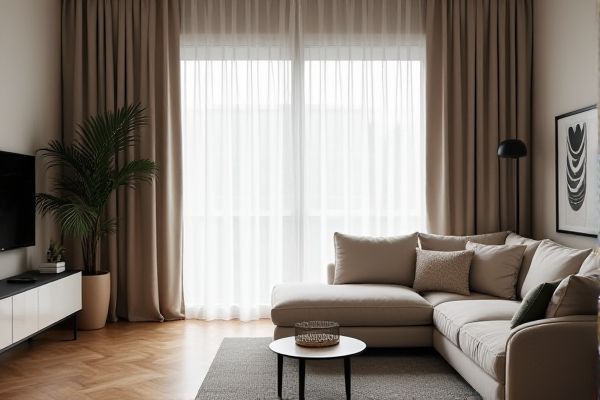
Blackout curtains block nearly all light, providing optimal darkness and privacy, while light-filtering curtains allow some natural light to pass through for a softer, diffused glow. Discover which option best suits Your needs by reading the rest of the article.
Table of Comparison
| Feature | Blackout Curtains | Light-Filtering Curtains |
|---|---|---|
| Light Blocking | Blocks 90-100% of light | Blocks 30-50% of light |
| Privacy | Maximum privacy | Moderate privacy |
| Insulation | Excellent thermal and sound insulation | Moderate insulation |
| Material | Thick, dense fabrics (polyester blends) | Sheer to semi-sheer fabrics (linen, cotton blends) |
| Use Case | Ideal for bedrooms, home theaters, and nurseries | Suitable for living rooms and areas needing natural light |
| Price Range | Moderate to high | Low to moderate |
| Maintenance | Machine washable but may require delicate care | Easy to wash and maintain |
Understanding Blackout Curtains
Blackout curtains are designed with dense, tightly woven fabrics or multiple layers that block nearly 100% of external light, making them ideal for bedrooms, media rooms, or nurseries where complete darkness is essential. These curtains provide enhanced insulation, reducing noise and improving energy efficiency by blocking heat and cold air from entering through windows. Compared to light-filtering curtains, blackout curtains offer superior privacy and light control, creating an optimal environment for sleep and relaxation.
What Are Light-Filtering Curtains?
Light-filtering curtains are window treatments made from semi-transparent fabrics that allow natural daylight to enter while diffusing harsh sunlight to reduce glare and provide moderate privacy. These curtains soften the light in a room, creating a warm and inviting ambiance without completely blocking the view outside. Unlike blackout curtains, which use thick, opaque materials to block nearly all light, light-filtering curtains balance illumination and privacy, making them ideal for living rooms and spaces where natural light is preferred with subtle light control.
Key Differences Between Blackout and Light-Filtering Curtains
Blackout curtains are designed with thick, opaque fabrics that block nearly 100% of external light, making them ideal for bedrooms, media rooms, or any space requiring complete darkness. Light-filtering curtains use lightweight, sheer materials that diffuse sunlight, allowing natural light to softly illuminate your room while providing some privacy. Choosing between blackout and light-filtering curtains depends on your specific needs for light control, privacy, and energy efficiency.
Benefits of Blackout Curtains
Blackout curtains provide superior light-blocking capabilities, making them ideal for improving sleep quality by eliminating external light sources. They also enhance energy efficiency by insulating windows against heat and cold, reducing utility costs. Noise reduction is another key benefit, as these curtains absorb sound, creating a quieter indoor environment.
Advantages of Light-Filtering Curtains
Light-filtering curtains offer the advantage of gently diffusing natural light, creating a soft, ambient glow that enhances room aesthetics while maintaining privacy. They reduce glare and protect furnishings from UV damage without completely blocking daylight, promoting a more pleasant and energy-efficient environment. These curtains are ideal for living spaces where a balance between light control and openness is desired.
Room Suitability: Where to Use Each Type
Blackout curtains are ideal for bedrooms, home theaters, or any space where complete darkness is essential for sleep, relaxation, or media viewing. Light-filtering curtains suit living rooms, kitchens, or offices where natural light is desired while reducing glare and providing privacy. Choosing the right curtains enhances Your room's ambiance and functionality based on lighting needs.
Impact on Energy Efficiency
Blackout curtains significantly enhance energy efficiency by blocking out sunlight and reducing heat transfer, which helps maintain consistent indoor temperatures and lowers heating and cooling costs. Light-filtering curtains allow some natural light to pass through while providing moderate insulation, offering less energy savings compared to blackout options. Choosing blackout curtains for your home ensures optimal temperature control and greater reductions in utility bills, especially in extreme weather conditions.
Privacy Comparison: Blackout vs. Light-Filtering Curtains
Blackout curtains offer superior privacy by blocking nearly 100% of light and visibility from outside, making them ideal for bedrooms and media rooms. Light-filtering curtains provide moderate privacy by diffusing natural light while obscuring direct views, suitable for living spaces where some daylight is desired without full exposure. The choice depends on the balance between privacy needs and natural light preferences.
Design and Aesthetic Considerations
Blackout curtains feature dense, opaque fabrics that block light entirely, offering a sleek, modern look ideal for bedrooms or media rooms where darkness is essential. Light-filtering curtains use lighter, semi-transparent materials that diffuse sunlight, creating a soft, airy ambiance while preserving privacy and complementing various interior styles. Your choice depends on whether you prioritize complete darkness for functionality or a gentle glow to enhance your room's aesthetic appeal.
Choosing the Right Curtains for Your Needs
Blackout curtains provide complete darkness by blocking nearly 100% of outside light, making them ideal for bedrooms and media rooms where total light control is essential. Light-filtering curtains allow some natural light to pass through while reducing glare and UV exposure, suitable for living rooms or spaces needing soft ambient illumination. Selecting the right curtains depends on your need for privacy, light control, energy efficiency, and the desired atmosphere in each room.
 homyna.com
homyna.com